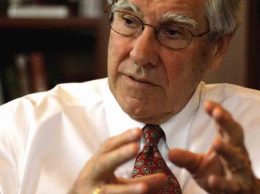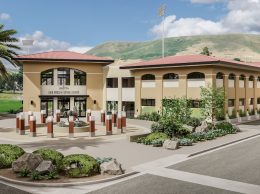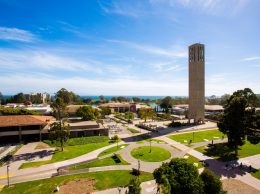Cal Poly envisions campus’ next two decades
IN THIS ARTICLE
- Latest news Topic
- Elijah Brumback Author
By Elijah Brumback Friday, November 7th, 2014
Big changes are in store for Cal Poly San Luis Obispo, but students, professors and SLO residents won’t know what will take shape for certain until early 2017.
The university announced Oct. 23 that it is entering a two-year master planning effort to determine future needs and what projects, from infrastructure to programing, will take priority.
“The master plan update is a crucial process that allows Cal Poly to create the infrastructure and environment necessary to support the university’s academic programs and advance its long-term vision,” said Cal Poly President Jeffrey D. Armstrong in a statement. “Given its significance, we encourage those on campus and in the community to get involved and share their input.”
A recent $20 million donation — the largest ever in the university’s history — from former Apple Chief Financial Officer Greg Oppenheimer and his wife Mary Beth is already slated for investment in four major projects within the Animal Science Department of the College of Agriculture, Food & Environmental Sciences.
However, those projects just scratch the surface of what university officials and project consultants are considering in setting the course of development over the next two decades. The whole effort to determine what’s next for Cal Poly is expected to cost $1.5 million.
“What we start with is the big picture,” said Linda Dalton, interim university planning officer. “Looking at the whole community of SLO, we want to look out another 15 to 20 years.”
While the major projects are yet to be determined, student housing, future programming and basic infrastructure, including traffic circulation are some of the overarching issues that university leaders want to address.
Cal Poly’s last master planning effort started in 1999 and was approved by the Board of Trustees in 2001. Before that there had been no update to the master plan since 1963. Because of the huge gap in the school’s long-term vision, 2001’s update was a comprehensive study of future needs. This time around, Dalton said, university officials can take what they like and what worked from the last update and modify it instead of doing a complete process from the ground up.
“We have put together six advisory committees and their first job is to look at the 2001 plan and on a topic by topic basis determine what’s still relevant and what needs to be changed,” she said. “We don’t have any findings yet, but at the same time we are starting staff on a number of technical analysis projects bringing all our campus data up to date.”
Some projects include, environmental impacts, water supply analysis, and land capacity and constraints, among others. The six committees include a cross section of campus and community representatives and are expected to provide ideas and input related to policy direction.
In a time line, Cal Poly officials anticipate several phases, starting with gathering background information. After the first of the year, Dalton said, the university will likely be looking at new policies to guide development and combining that with committee and public input. Writing the new master plan will tentatively take place through spring and summer, followed by a long and intensive environmental review process.
As a benchmark on physical infrastructure at Cal Poly, the 2001 master plan set the course for the build-out of roughly 2 million square feet at a cost of about $750 million. According to the most recent economic impact report, annual spending related to Cal Poly San Luis Obispo is $655.7 million and generates a total impact of $469 million within the regional economy, and nearly $951 million on the statewide economy. As the campus grows, those numbers are expected to increase.
“The last master plan guided a huge number of projects,” Dalton said. “We’ve pretty much built out everything that was put in that plan.”
Projects from the last plan included several engineering buildings, the stadium expansion, a new construction management building, the Poly Canyon Village student housing complex and a number of agricultural related buildings.
The new 189,000-square-foot Warren J. Baker Center for Science and Mathematics opened for classes in the fall 2013 and was the last project completed from the 2001 master plan. Every Cal Poly student will take a class in the building. The $119 million project was paid for by voter-approved state education construction bonds and $19 million in private donations.
Going into the next master plan, it’s obvious that money to fund projects and locating sources of capital will be the single biggest determinant in what that university can get done. Once the master plan process reaches the final stages,
Cal Poly will launch a comprehensive capital campaign to meet its objectives, Dalton said.
“One of the big things you can’t plan is when you’re going to get the money to build buildings,” she said. “Looking ahead at the capital budget, we do our best to plan the outlay of resources and we’ll be looking at that again.”
Building projects funded by the Oppenheimer gift include: a new Agricultural Events Center capable of supporting livestock events, industry activities and conferences and the college’s student experimental learning programs. The 70,000-square-foot indoor arena is expected to seat more than 2,500 guests, with a floor that converts to conference space. The center will also have classrooms supported by the latest technologies. It will be located where the beef unit currently stands on Via Carta.
A new Equestrian Pavilion is also planned on Via Carta that will add needed arena space for current equestrian programs and expanded events on campus. The pavilion will feature both partially enclosed and covered arenas, approximately 60,000 square feet each, with supporting facilities and vehicle parking to accommodate visiting horses.
Additionally, a new Farm Store to support the sales of all meat, poultry, dairy, crop and horticulture products produced on campus by Cal Poly students will also be built. With the new facilities, a final project entails the modernization and expansion of facilities and equipment at the current animal teaching and research centers.
The next public planning meeting is Saturday, Nov. 15, from 10 a.m. to noon at the Ludwick Community Assembly Room in San Luis Obispo.
Additional opportunities for public involvement and input are being scheduled and will be announced at a later date as part of the master plan update process, the university said.
“Were mostly there to listen right now,” Dalton said of the upcoming sessions. “We want the community to show us issues and concerns, then later next March we’ll do this again and have materials to share and get reactions.”
Related Articles
 Friday, October 14th, 2022
Friday, October 14th, 2022










